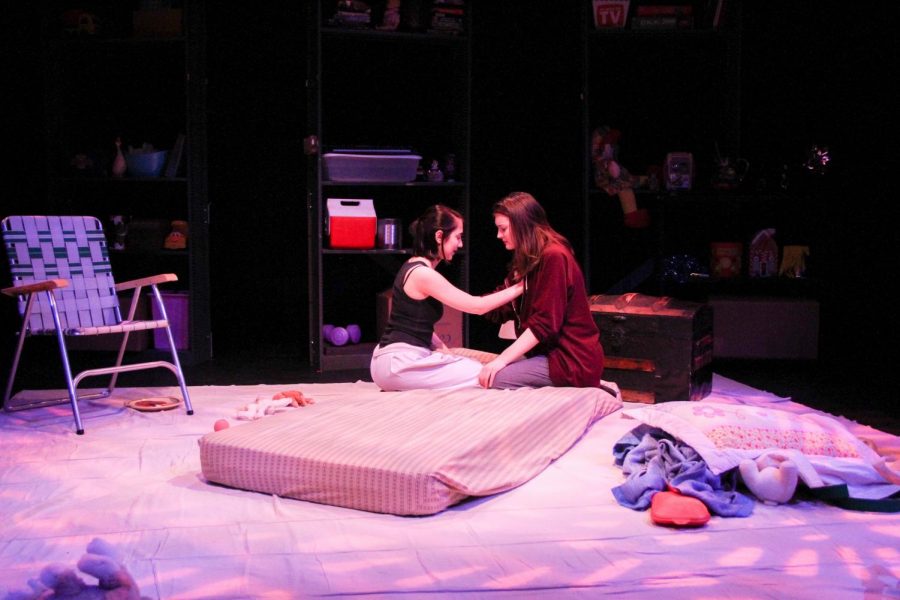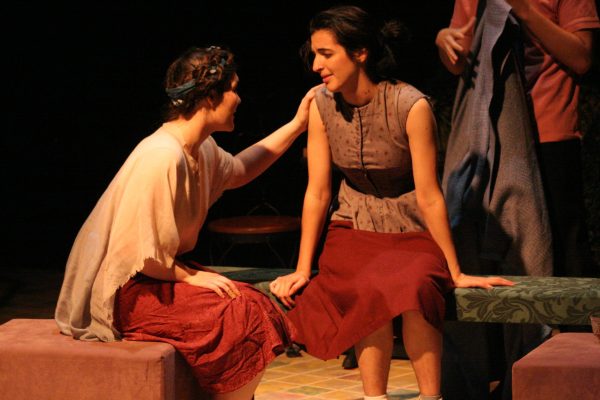“Chamber Play” Delivers Performance on Cyclical Abuse
Students stage Chamber Play in Kander Theater. Chamber Play is a dark drama about amnesia and sexual abuse written by Amanda Faye Martin and directed by College senior Zoë Kushlefsky.
Editor’s Note: This article contains mention of sexual abuse and trauma.
Chamber Play, written by Amanda Faye Martin, is the dark, cryptic story of several characters, particularly Amanda (played by College first-year Sofie Rejto) and Sabina (played by College first-year Anna Aubry), and their experiences with cycles of abuse. The play examines amnesia as a result of sexual trauma, implying certain side effects of post-traumatic stress and illustrating the almost involuntary nature by which a victim becomes a perpetrator. Aside from sexual assault, the play also handles issues of agoraphobia, safety, and abuse in parent-child relationships.
Martin received her Bachelor of Arts degree from Kenyon College and MFA from Harvard University. She is trained in dramaturgy and playwriting, and she also attended Trinity College in Ireland, the Moscow Art Theatre in Russia, and the Ludwik Solski Academy for the Dramatic Arts in Poland. Her friend and College senior Zoë Kushlefsky, who directed the play, brought Chamber Play to Oberlin. The production premiered yesterday and will run until March 31 in Kander Theater, Hall Annex.
Martin’s stint at the Moscow Art Theatre seems to explain the Strindbergian nature of Chamber Play, which includes confusion between the real and the imaginary, and often uses music to convey subtle meaning.
“It very much flows between reality and imaginary,” Aubrey said. “There are times when you can’t tell who’s real and who’s not, and what’s truly happening and what’s not.”
As audience and actors are placed on the same level, the play is incredibly intimate. The set is a small basement decorated to suit 14-year-old Sabina’s room. The audience is peering into what Kushlefsky describes as “four glass walls,” and further, delving into the psychological complexities of the characters.
“[This theater] is a much more intimate space than Warner Main, and it’s a much more accessible space than the Cat [in the Cream],” said College sophomore Abigail Bowman, who plays Sabina’s mother, Zoe. “Since you’re on the same level as the audience, it’s much easier to form a connection with audience members — not necessarily that you have any interactions with them, but it’s easier to sense emotion and feeling and how what you’re saying and what you’re doing is affecting the audience.”
The cast and crew repeatedly stressed the fact that they are not attempting to generalize human responses to abuse, making abundantly clear that the story is illustrating the events of certain individuals alone.
“There’s no real moral I’m trying to push or anything,” Kushlefsky said. “I hope people can see this as a stand-alone narrative and one example of one person’s experience. I think there’s a problem in stories of sexual assault where it’s like, ‘If you are assaulted, this is how you will react,’ which is not the case at all. People aren’t monolithic like that at all.”
The timing of this play is very apt considering the current #MeToo movement and several media role models being called out for sexual assault. While the play is more about acknowledging one’s role as a carrier of trauma and understanding the caution such carriers need to demonstrate in their future relationships to prevent the cycle from continuing, it also serves to start the conversation, fighting the taboo nature of the topic and beginning the healing process.
“There’s no one way to heal from something like sexual assault, but I think that this national movement and this sort of union and … ‘sisterhood’ that’s forming is a really powerful thing,” Kushlefsky said. “And I think that the #MeToo movement is an important intervention for that kind of thing, because I think that reckoning with and understanding your own personal issues is, for many people, the first step to healing, whatever that means to someone. To finding some kind of peace. And that’s part of it, for this character [Amanda] in this play. She doesn’t even know what happened to her, so she can’t reckon with it until it’s too late and she’s continued the cycle.”
In such a serious play, it seems absurd that it could create any moments of comic relief — yet it does. The comedy is not quite dark humor, nor is it slapstick or insensitive in any way. Instead, it is subtle — describing a traumatic event as boomerang-like in its relentlessness, for example — offering a momentary break from the intensity of the subject.
“Obviously, in a play, sometimes things are going to be highly dramatized,” Aubry said. “So I think just making sure at every step of the way to be considerate of the subject matter [is important.] It’s easy for the room to get really somber when talking about these things, and I think we’ve done a good job of keeping it light-hearted but at the same time … also understanding the moments when you have to be a little bit more serious about it.”
Chamber Play lends a window into the psyche of someone who has faced a traumatic incident, and often features troubling content and can at times be difficult or triggering to watch. However, it is an important piece for both assault victims and those who have committed assault either knowingly or unknowingly.
“Be warned that it’s a heavy play, but it is so worth it to see,” Bowman said. “Even though it has these heavy things, it handles them so well and it’s so beautifully written. It takes this really ugly concept and turns it into a beautiful piece of art.”








